AP PSYCH UNIT TWO NOTES
Interation of Heredity and Environment:
The main idea is the question “are we shaped by our genes or our experiences?”
Psychology tries to understand how both of our inherited traits (nature) and our surroundings (nuture) work together to make us who we are.
Nature (Heredity): refers to our genetic makeup (DNA)
Nuture (Environment): our culture and experiences
Genes and environment interact, because while genes may set the stage, environment determines the outcome. Your predisposition could influence the environment you seek.
Behaviors have evolved over time to help us better survive and reproduce.
Natural Selection: traits that enhance survival get passed down
Mutations: random changes in DNA that can lead to new traits
Scientists can study nature vs nuture using:
Twin Studies: Comparing identical (monozygotic) with fraternal (dizygotic) twins to see how much behavior is determined by genetics vs enviornment
Adoption Studies: examining if adopted children are more like their biological or adopted parents
Family Studies: analyzing the shared traits among relatives
Twins can be used as well.
Identical Twins (Monozygotic): shares 100% of the genes
Fraternal Twins (Dizygotic): shares about 50% of the genes
Genes: the basic units of heredity
Genome: a complete set of genetic instructions for an organism
Epigenetics: how an environment can influence gene expression WITHOUT changing the DNA
Eugenics: controlling populations by selective breeding
Problems with Eugenics included: Racial and Class Bias, Forced Sterilization, and Violation of Human Rights. It oversimplified genetics, and was used by extreme ideologies and was based on prejudice instead of science.
The Neuron:
Anatomy and Firing:
Dendrite: branch-like structures that extend out of the cell body and recieves neurotransmitters from other neurons
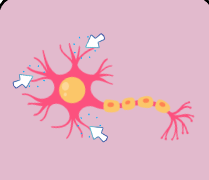
Soma: the cell body that contains the nucleus. It determines when the neuron will fire and is the support system for the nerve cell.
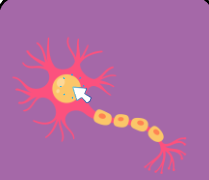
Axon: a pathway the electrical impulse will travel down and the electrical signal causes the neuron to fire
Myelin Sheath: a coating that protects the Axon and also helps speed up the electrical signal
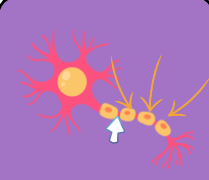
Terminal Branches: a part of the axon with a frayed structure. The end of the branches holds terminal buttons and inside the terminal buttons are vesicle sacs that hold neurotransmitters.
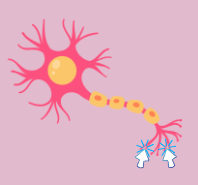
Synapse: the space between two Neurons (Neurons never touch!) When a neuron fires, the neurotransmitters go into the synapse to be picked up by other neuron’s dendrites.
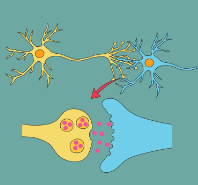
Resting Potential: during resting potential, the dendrites are waiting for the chemical signal (neurotransmitters). When in resting potential, the neuron is polarized. Potassium (+) ions are inside the axon and Sodium (-) ions are outside the axon.
Action Potential: When enough neurotransmitters have entered the dendrites and the neuron reaches the threshold, the soma activates the action potential. This causes an electrical signal to move down the axon. Once action potential initiates, channels open along the axon and Sodium (-) ions flood into the axon. This is known as depolarization. When the Sodium and Potassium mixes, an electrical signal is generated and travels down the axon.
Neuron Firing: When the electrical signal reaches the axon terminals, the neurotransmitters are released into the synapse to attach to other neurons’s dendrites. Any leftover neurotransmitters are reabsorbed by the firing neuron, this is known as reuptake.
Refractory Period: After the neuron fires, it can rest and recover. The neuron cannot fire during this period no matter how many neurotransmitters it has. Once this period is over, it is at resting potential.

Multiple Sclerosis: a disease caused by the deterioration of the myelin sheath. People who suffer this disease have difficulty moving and walking.
Myasthenia Gravis: an autoimmune disorder that makes antibodies that block/destroy muscle receptor sites with a neurotransmitter called acetycholine. This causes muscle weakness.
Neurotransmitters:
Excitatory: causes the neuron to fire
Inhibitory: does not cause the neuron to fire
Acetycholine: enables movement which is transmitted from motor neurons to the muscles. Also involved in learning and memories (Excitatory)
Dopamine: Helps the brain coordinate and initiate physical movement. It is released in response to pleasurable experiences It stimulates the hypothalamus. Influences motivation, good-directed behavior, cognition, and executive function. (Excitatory/Inhibitory)
Serotonin: Involved in sleep and mood/arousal/apetite/digestion regulation. It can be linked to anxiety, worry, nervousness, and sleep-difficulties. (Inhibitory)
Norepinephrine: Involved in promoting wakefullness, alertness, and arousal. Helps initiate the fight or flight response and is released in response to stress. Also a hormone. (Excitatory)
GABA: Makes it less likely for a neuron to fire and reduces brain activity. (MAJOR Inhibitory)
Glutamate: Makes it more likely for a neuron ti fire, increases brain activity, and is involved with learning and memory. (MAJOR Excitatory)
Endorphins: Regulates the perception of pain, can reduce the body’s stress response, and enhances the mood. (Inhibitory)
Substance P: involved in the perception of pain. Plays a role in promoting inflammation in response to injury and regulates emotion/social behavior. (Excitatory)
Nervous System and Endocrine System:
The Nervous System:
It acts as the body’s control center and communications network which allows us to move, think, feel, and react to our surroundings.
Nervous Systems Function:
Sensory Input: the nervous system gathers information from our senses (the five senses) and sends it to the brain.
Integration: the brain processes information and makes decisions on what to do
Motor Output: the brain sends signals to muscles and glands to make the body respond, like making moving your hand or releasing hormones
Central Nervous System:
Brain: the “boss” of the nervous system. Controls our thinking, feeling, and moving. Also processess information from our senses.
Spinal Cord: the "highway” that connects the brain to the rest of the body. Sends messages back and forth between the brain and different body parts.
Peripheral Nervous System:
Nerves: the wires that connect the brain and spinal cord to the rest of the body and carries messages to and from the brain and spinal cords. They are bundles of interconnected neurons.
Somatic Nervous System: the part that controls voluntary movements
Autonomic Nervous System: the part that controls involuntary movements
Autnomic Nervous System:
Sympathetic Nervous System: the fight, flight, or freeze response.
Parasympathetic Nervous System: calms you down, rest and digest
Types of Neurons:
Sensory (afferent) Neurons: takes messages from your sensory receptors (five senses) to your brain and spinal cord
Motor (afferent) Neurons: transmits signals from your brain to the muscles and organs
Interneurons: relay neurons (connectors) and allows for information to pass between neurons and between the spinal cord and brain
Reflex: a simple automatic response to a sensory stimulus. (This movement is directed by the spinal cord instead of the brain)
The Endocrine System:
It is the system of glands in our body that circulates and regulates hormones. Hormones affect behavior and mental processes like neurotransmitters do. The hormones are circulated through the bloodstream. This means the hormones are slower but more long lasting.
Pituitary Gland: considered the “master gland” of the endocrine system. It regulates stress, growth and reproduction. This gland sends signals to other glands to release their hormones.
Hormones to know:
Adrenline: a hormone secreted by the adrenal glands, which are located at the top of your kidneys. It increases your heart rate, blood pressure, and blood sugar giving us a surge of energy. Also known as the fight or flight response.
Gletin: a hormone produced in the stomach. It tells you when your body is hungry and needs food.
Leptin: produced in the small intenstine. It tells you when your body is full/satiated.
Testosterone: a hormone produced by both men and women. The hormone responsible for human sex drive.
Estrogen: a hormone that is important for reproduction.
Oxytocn: called the “love hormone”. It produces positive feelings (serotonin and endorphins).
Melotonin: It regulates his circadian rythms and helps you sleep.
The Brain:
The brain is most plastic when it’s young.
Severed neurons do not reattached when severed.
Lesions: destruction of brain tissue
EEG: a recording of the electrical waves sweeping across the brain surface
PET: traces where the radioactive form of glucose goes when the brain is in use
MRI: makes images from signals produced by brain tissue after the magnets align the spin of atoms
Functional MRI (FMRI): reveals brain activity and function
Brainstem (Medulla): controls breathing and heart rate
Reticular Activating System: filters and relays stimuli/information. Controls arousal and sleep/wake system.
Cerebellum: controls coordination of muscle movement, balance, and procedural learning
Cerebral Cortex: the wrinkled outer layer
The Limbic System:
Thalamus: decides where information needs to go. Does with all sensory information (besides smell). Sends information to the cerebral cortex.
Hypothalamus: it’s role is to keep the body regulated and it enables the parasympathetic nervous system to maintain homeostasis. Responsible for hunger and thirst, and keeping our body temperature normal. It is the brain’s reward center and holds the dopamine pathways.
Pituitary Gland: It is controlled by the hypothalamus and is referred to as the “master gland”. Responsible for the release of hormones and works with our growth and development.
Hippocampus: crucial for learning, memory, and converting short term to long term memories
Amygdala: responsible for fear and agression when exposed to a threat. “Fight or flight” response.
The Lobes:
Occipital Lobes: controls visual information processing
Temporal Lobes: responsible for auditory/linguistic processing. The association area that recognizes faces
Wernicke’s Area: controls speech comprehension. Wernicke’s aphasia: when you have difficulties with spoken languages
Parietal Lobes: processes and organizes information. The somatosensory cortex.
Somatosensory Cortex: processes touch sensitivity
Frontal Lobes and Prefrontal Cortex: involved in linguistic processing, higher-order thinking, and executive functioning
Motor Cortex: controls the skeletal movement. also controls voluntary movement.
Broca’s Area: the frontal lobe on the left hemisphere and is responsible for speech production.
Corpus Callosum: a band of neural fibers that connect the two hemispheres of the brain. Enables communication.
Association Areas: part of the cerebral cortex that allows for certain functions.
The Two Hemispheres:
The two hemispheres serve different functions.
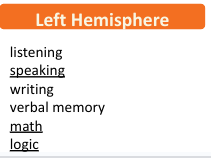
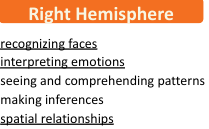
Split Brain Patients: people with a corpus callosum that’s severed